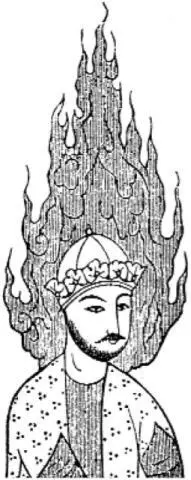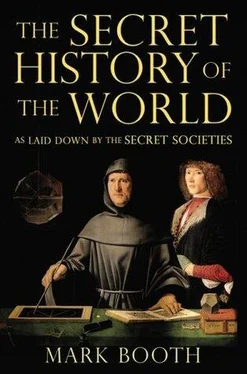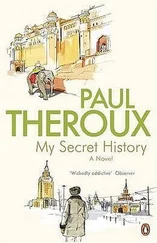According to Clement of Alexandria, the curtain which sectioned off the Holy of Holies had cut into it the shape of a five-pointed star. The five-pointed star has always been a symbol of Venus, because the pattern that Venus traces around the ecliptic in its eight-year cycle — five appearances in the morning sky and five in the evening sky — forms a five-pointed pattern. It is the only planet to draw a completely regular figure in this way. This figure is seen sometimes as a pentagram, sometimes as a five-pointed star, and sometimes, as we shall see when we come to investigate Rosicrucianism, as a five-petalled flower, the rose.
As well as being a symbol of Venus, the pentagram is highly significant in geometry because, as Leonardo’s mathematics teacher Luca Pacioli revealed in his book on divine proportion, it embodies the Golden Proportion in every part of it.
But there is more. This sacred geometry operates in time as well as space.
Five Venus cycles of 584 days take place over exactly eight solar years, which means that a Venus cycle is 1.6 of a solar cycle. We have come across this number 1.6 before. It is the beginning of the Golden Proportion, one of the irrational and magical numbers that describe the precipitation of mind into matter.
In the ancient and secret doctrine, the planets and the stars control this precipitation of matter.
The Venus associations multiply, one dimension opening up into another like the bubble universes of modern science. There are many rival etymologies of the name Jerusalem, one being that the original name of the city was Urshalem, ‘ur’ meaning founded by and ‘Shalem’ being an ancient name of Astarte — or Venus — in her evening setting. In Masonic tradition its own lodges are modelled on the Jerusalem Temple. The five-pointed star of Venus is represented above the ceremonial chair of the Grand Master, and initiates greet each other in a fraternal five-pointed ceremonial embrace. Lodges contain dormer windows, aligned in such a way that the light of Venus shines through them on certain important days. A Master mason is raised into rebirth facing the light of Venus at an equinox.
Bearing in mind the identification of Venus with Lucifer, these associations might at first seem a bit disconcerting. But in esoteric history Lucifer is always a necessary evil. The human capacity for thought was forged out of a balance between Venus and the moon — and the moon, as we have just seen, also features prominently, in the design of the altar of the Temple.
The mission of Solomon was to lead humankind down into a darkening, more material world, keeping the flame of spirituality alive. It was the same mission that Freemasonry would take up in the seventeenth century at the dawn of the modern age of materialism.
THE SOLOMONIC LEGENDS FIND A DISTANT echo in the British Isles. Modern scholarship tends to hold the view that, if the legends of Arthur have any historical basis at all, this lies in the ‘Dark Ages’ following the withdrawal of the Romans from Britain, when a Christian warlord might have fought glorious but ultimately futile battles to repel pagan invaders. An intriguing case has been made that the historical figure behind the Arthur legends was Owain Ddantgwynne, a Welsh warlord who defeated the pagan Saxons at the Battle of Badon in 470. Arthur would in this case have been a title, meaning ‘the bear’.
But the original King Arthur lived at Tintagel a little earlier than Solomon, in about 1100 BC, when the peaceful, rural communities of Bronze Age Britain were overrun by the more militaristic hill-fort people of the Iron Age. His spiritual mentor, Merlin, the wizard of Cellydon Wood, was a survivor from the age of the stone circles. He helped Arthur to keep the Sun Mysteries alive. King Arthur himself was a Sun king, surrounded by the twelve knights of the zodiac and married to Venus, Guinevere being the Celtic form of Venere or Venus. His crown was a crown chakra ablaze to lead his people — as Solomon led his people — down through the darkness.

Herodotus recorded that in Iran the king was believed to emit such an intense unbearable light that he had to remain behind a curtain during audiences with his subjects. A crown was a symbol that a certain grade of initiation had been achieved and that the initiate was crowned with buddhic fire.
13. REASON — AND HOW TO RISE ABOVE IT
Elijah and Elisha • Isaiah • Esoteric Buddhism • Pythagoras • Lao Tzu
AFTER SOLOMON THE KINGDOM OF ISRAEL began to fall apart again.
An institution grew up called the prophets. Their role was to advise the kings — except that, unlike the relationship between Melchizedek and Abraham or Merlin and Arthur, theirs was adversarial, even subversive. They said uncomfortable and unpopular things no one wanted to hear. They ranted and raved. Sometimes they were thought of as mad.
Elijah was a wild man, strange and solitary, almost like a tramp, with a leather belt and a long cloak. Like Zarathustra he fought fire with fire.
Told by God to hide in the wilderness and to drink from a brook, he was fed by ravens. ‘Raven’ indicates that Elijah was being initiated in the ways of the wisdom of Zarathustra. ‘Raven’ was one of the grades of initiation in his mysteries.
The king of Israel, Ahab, married Jezebel and began to erect altars to Baal (the Canaanite name for Saturn/Satan). Elijah fought and won a battle with the prophets of Baal, calling fire down from heaven. On later occasions he called fire down from heaven to kill squads of soldiers sent by Jezebel to capture him.
Elijah was a man of blood and thunder, the prophet who lived closest to the borders of madness. There are stories of repeated, astonishing proofs of his charisma — his clairvoyance, his ability to turn a poisoned well wholesome, to make iron float, to heal a leper. There is a strange story of his bringing a young boy back to life by lying on top of him and infusing him with his spirit. When he had to flee into the wilderness again, he was fleeing for his life — and towards God. He found himself standing on a mountain in the middle of a terrible, raging storm. We may imagine him railing against the storm, a combination of Lear and the Fool.
Eventually he sank down, exhausted, and slept under a juniper tree, where he had a dream of an angel.
Then, while it was still dark, he set off to climb Mount Horeb in search of God as the angel had told him. But a great wind came, shaking the very mountain and sending enormous boulders bouncing down in his direction. Elijah knew that God was not in this wind and he managed to reach the safety of a cave.
Suddenly a sheet of lightning struck the ground right in front of the cave, causing a roaring blaze in the vegetation outside, which trapped him inside. He also knew God was not in this fire.
After a while the storm and the fire died down and as morning approached all was calm. The morning star arose and it was then, in the gentle morning air, that Elijah heard the still small voice of God.
An exuberant, even outrageous figure, he was nevertheless the prophet of a new interiority. This is a development of Moses hearing of the voice in the burning bush, but quieter, subliminal almost. Where people had once had an overwhelming sense of the divine, now they would have to listen very intently, to practise mental discipline and directed attention in order to discern it.
But in order to understand the true meaning of Elijah’s mission, it is necessary to understand his death, and in order to do that we will turn first to India.
There are testimonies about Indian adepts able to dematerialize and materialize at will. In Paramahansa Yogananda’s marvellous Autobiography of a Yogi , first published in 1946 , he describes how he was due to meet his spiritual master, Sri Yukteswar, at the local train station, but received a telepathic message not to go there. His master had been delayed. The pupil waited in the hotel. Suddenly a window overlooking the street became brilliant with sunlight and his master clearly materialized in front of him. His master explained that he was not an apparition but flesh and blood, that he had been divinely commanded to give his pupil this very rare experience. Paramahansa Yogananda touched the familiar sandals made of orange canvas and rolled with rope. He also felt the ochre cloth of his master’s robe brush against him.
Читать дальше













